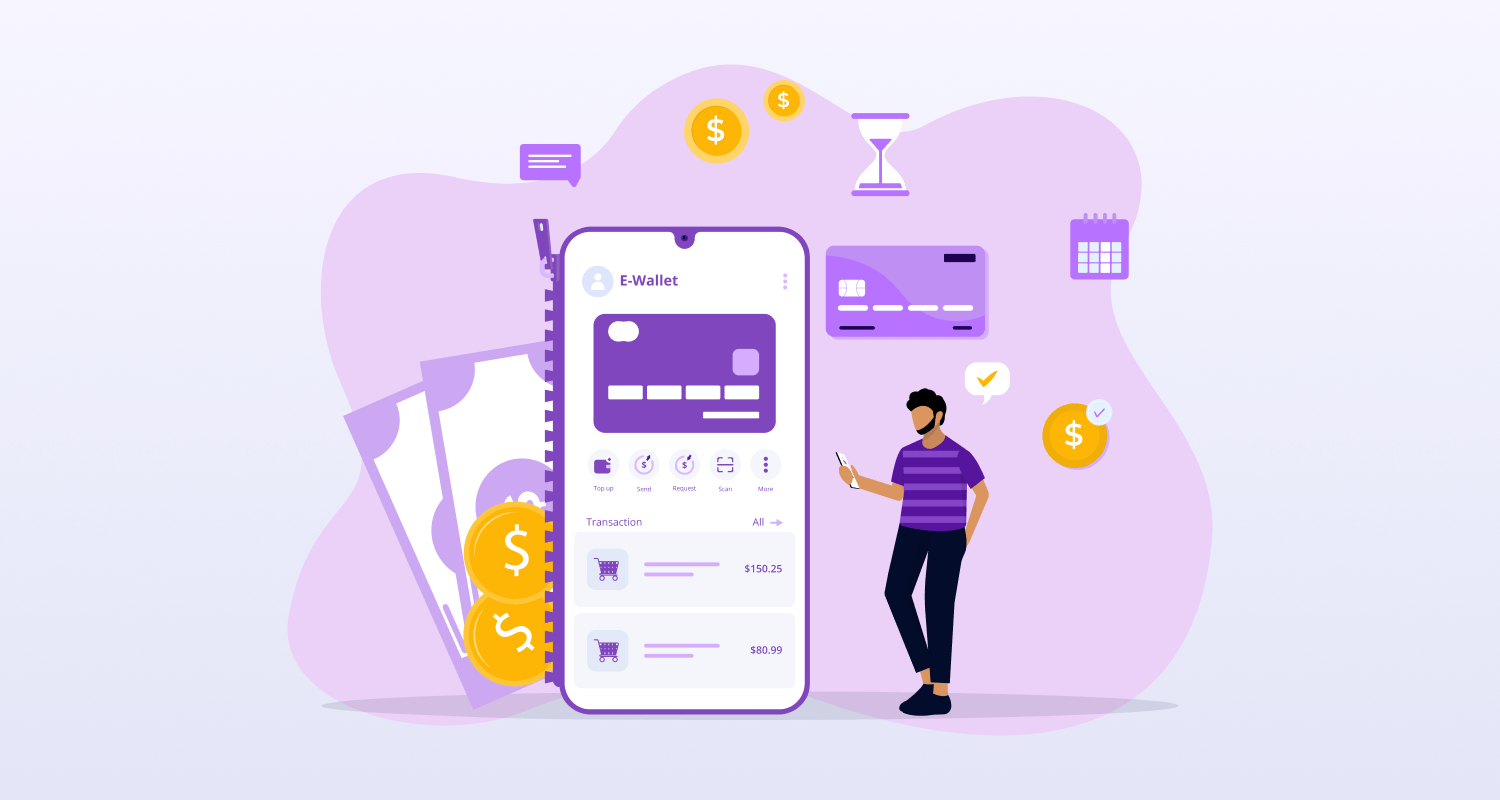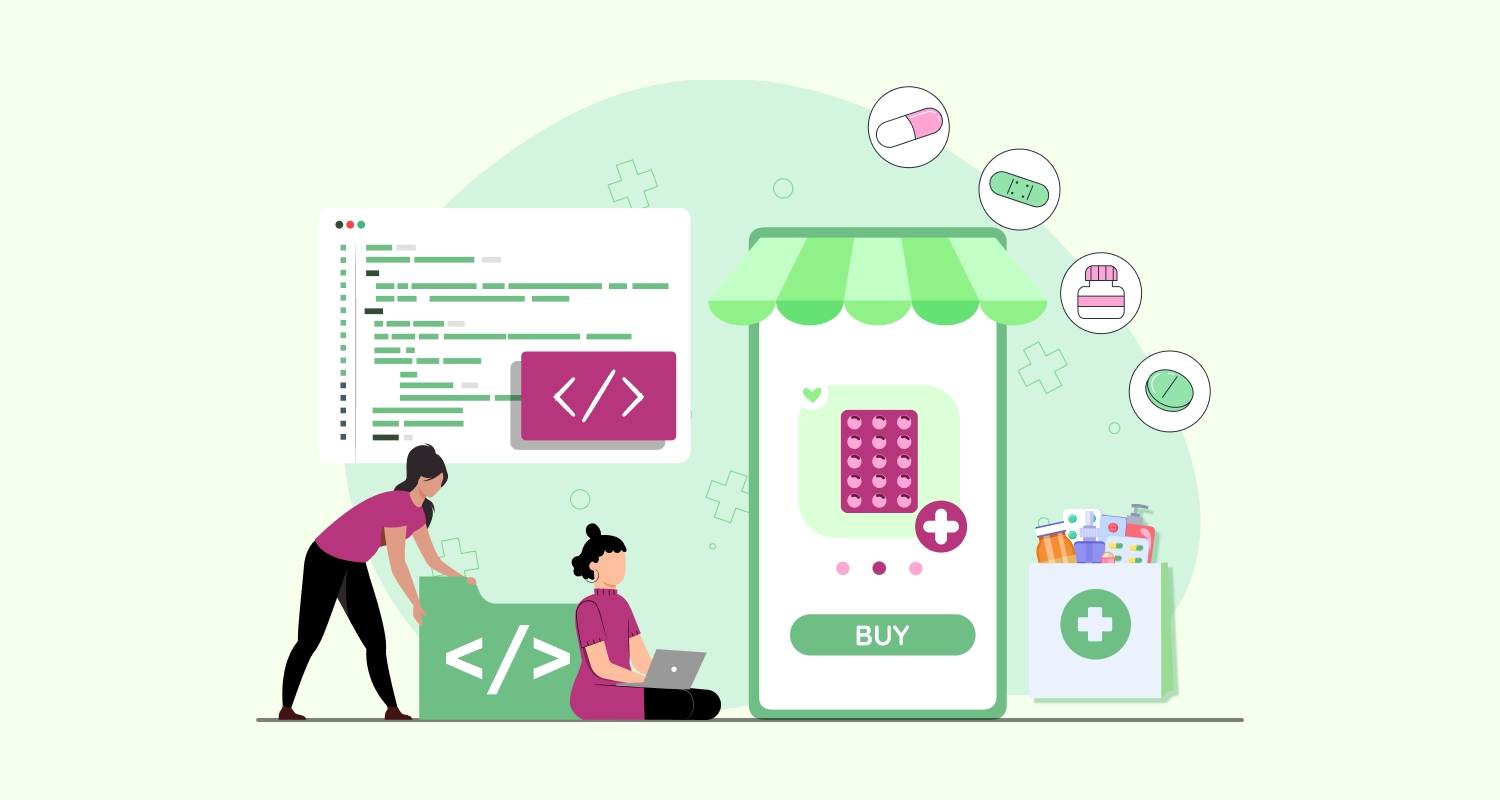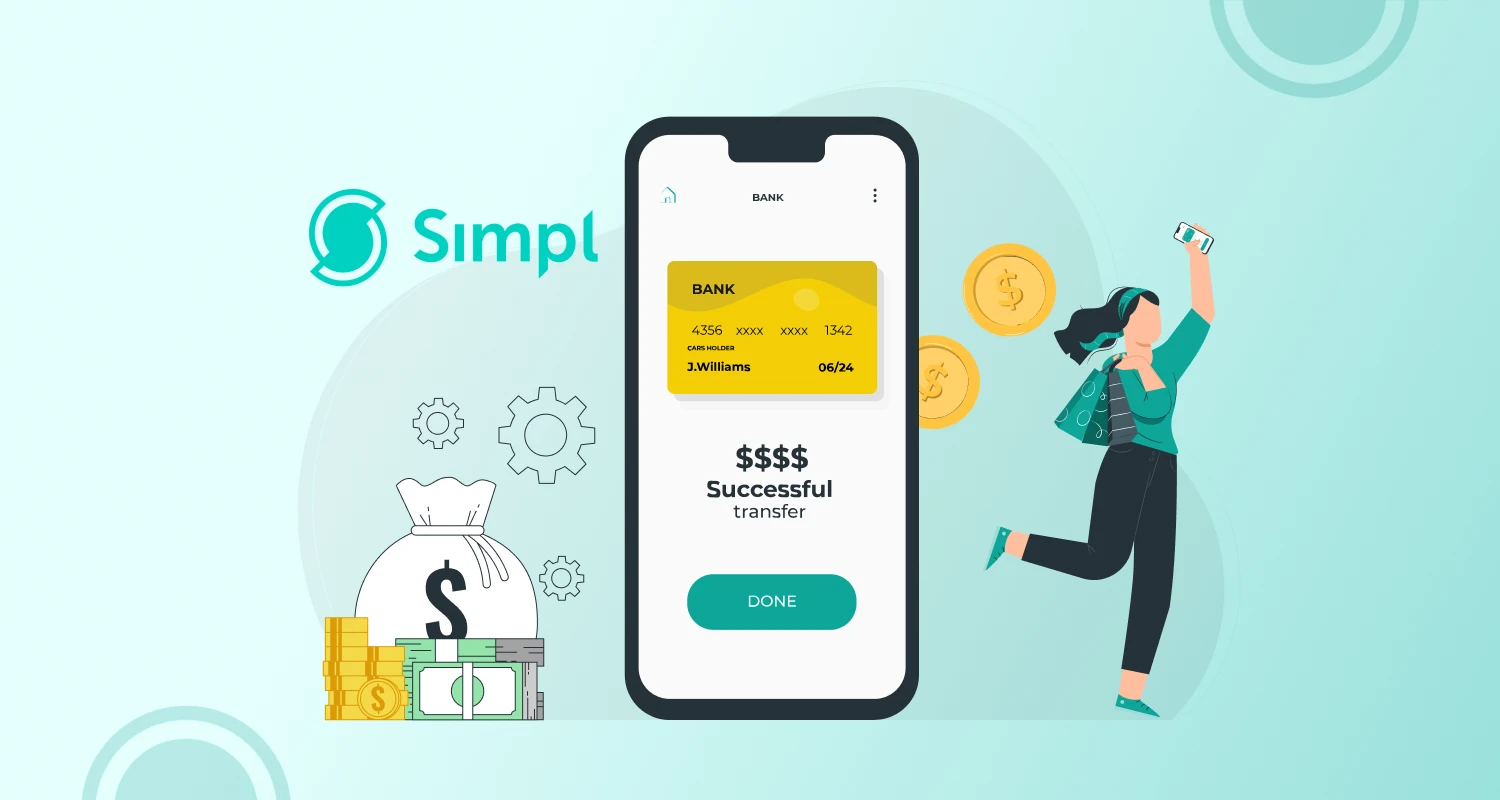The digital revolution has transformed almost all aspects of our lives. We are now saving a lot of time and effort than ever before.
The benefits of shopping from the comfort of your home to discovering meetings or learning new skills, everything can be done through a smartphone. Not only this, you can even send and receive money using your smartphone. In this regard, peer-to-peer payment app have made a mark as an efficient money-sending and receiving service.
These payment methods are considered safe by many people. This is why more people are using these. Thus, developing payment apps can be a hugely profitable business idea currently. This article covers all the important details of how to build a P2P payment app.
What Is a Peer-to-Peer Payment App?
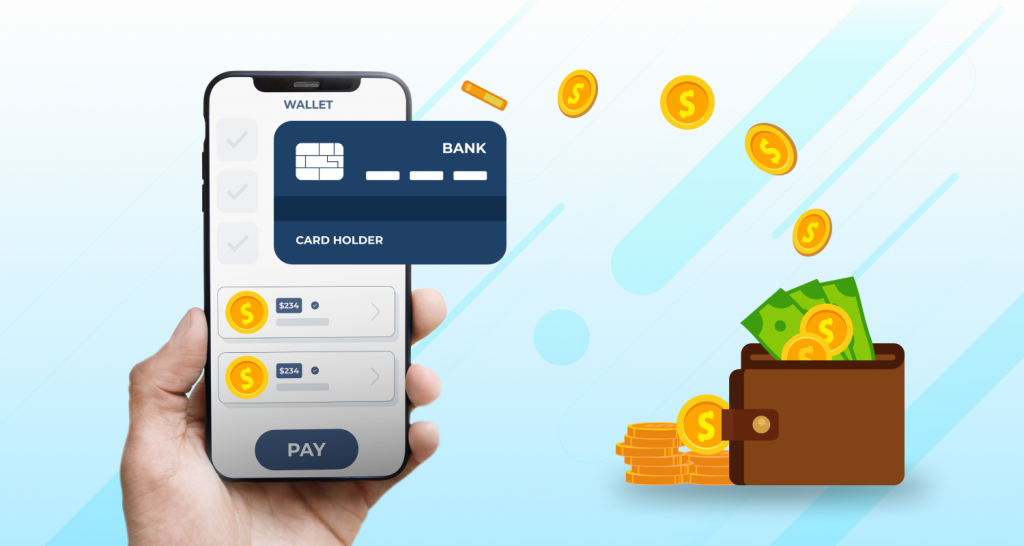
Peer-to-peer payment app are also known as person-to-person payments. These refer to the financial transactions from the bank account of one person to another with the help of a mobile app. These apps are known as peer-to-peer applications. These apps can be used for various types of financial transactions like payments for lunch or buying a book.
One of the most popular peer-to-peer payment apps is PayPal. It is one of the first services to occupy the niche of P2P payments. Today the system is used in many mobile applications. Although many other platforms have also entered the P2P payments market around the world. We will now look at the types of P2P apps.
How Does a P2P Payment App Work?
Setting up P2P payment accounts is rather simple. The choice of platform does not matter. You are required to sign up for an account and then link your card or bank account to the service account.
Registration and Login
first create an account on the app by providing your contact information, including your name, bank name, phone number, address, city, etc. You must then enter a secure password or PIN.
Adding payee
Once you complete the registration, you need to fulfill the KYC process. The information for the individual you want to pay must then be added. The user will want the recipient’s name in order to complete this step.
Defining the amount
The amount you intend to transfer must be specified. You can also include the justification for the payment with this. This can, however, be optional.
Enter the password to confirm the transaction
You must enter the password that you chose when you signed up, or you may use an OTP to authenticate the payment transfer. In addition, if you forget your password, you can create a security question.
Receipt of payment
A payment receipt is then generated instantly and is available for download or printing. You can keep track of all of your financial transactions in this way.
How Many Types of Peer-to-Peer Payment Systems are There?
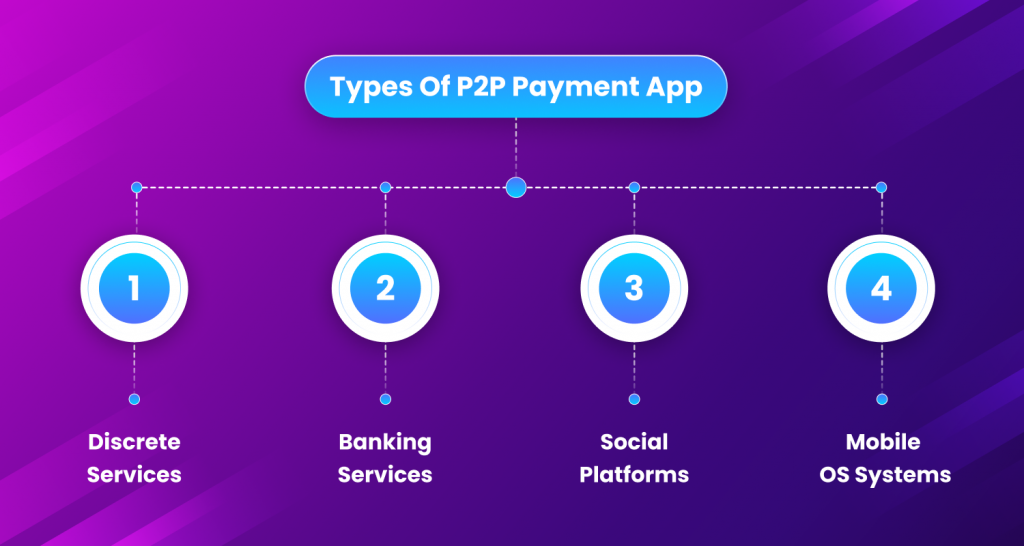
1. Discrete Services:
P2P suppliers have their own mobile P2P app solutions that make it easier to transmit money. Each of them has a wallet function that helps them keep their money safe.
Two of the leading financial services in this segment are Venmo and PayPal. PayPal has an extended network of over 202 countries with more than 250 million users transacting funds.
Venmo is the most rapidly growing service in the category. The app has witnessed severe growth in its total volume of payments by approximately 58% in the second quarter of 2021. The fourth quarter of 2020 saw a growth rate of approximately 47%.
2. Banking Services:
Bank-centric peer-to-peer payment apps are P2P programs that include a bank as one of the parties in the transactions. This segment has two types. One with the banks having their own smartphone apps. Second with the p2p payment apps that make transactions via different financial organizations. They transact via credit unions, financial security businesses, financial institutions, and partner banks.
One of the best and safest platforms in this category is Zelle. Developed by the banking institutes of the US, it matches all the safety standards that banks need. This app directly draws and deposits money into the bank account. This does not use a wallet feature.
3. Social Platforms:
Social media platforms can also use P2P payment systems. Facebook launched its payment feature Facebook Pay in 2015. The feature is available in messenger where users can transfer funds using the app.
Snapchat also launched Snapcash, its payment feature before Facebook. However, they scrapped it on 30th August 2018.
Following the footsteps of Facebook, WhatsApp also launched its payment feature in India which gained tremendous popularity. Google also acquired Softcard, a platform for mobile wallets. It was a joint venture of AT&T, T-Mobile, and Verizon.
4. Mobile OS Systems:
As clients can now complete transactions more quickly and easily, mobile operating systems have grown to become a popular trend. Customers conduct various banking transactions and pay their bills in significant numbers all across the world.
A service provider can monitor emerging cyberthreats in real-time with a mobile OS system and notify clients as soon as they arise. Additionally, it prevents payment fraud.
SEE ALSO: Personal Finance App Development
Which Features Do You Need in Your P2P App?
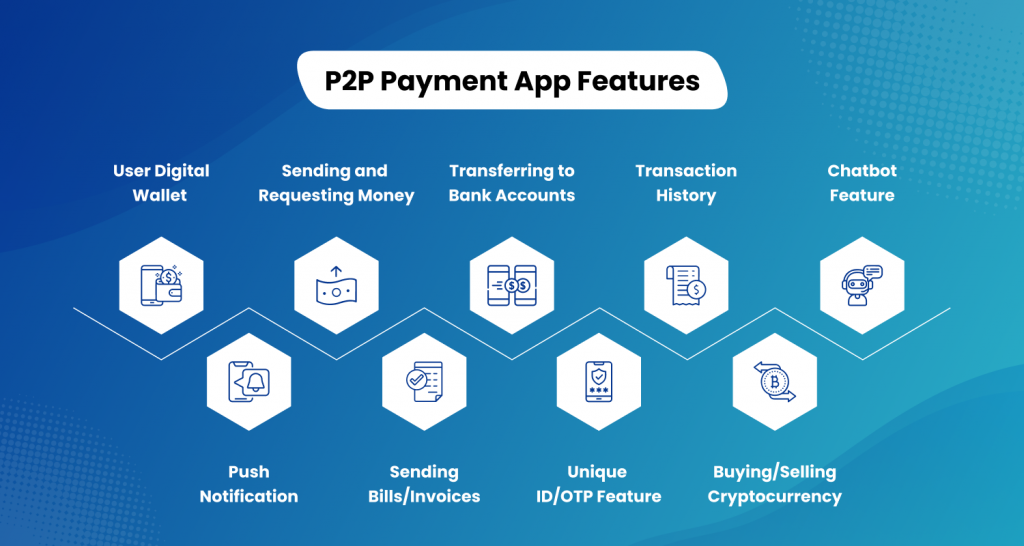
If you want to develop a P2P app of impeccable quality, you must include a few features.
User Digital Wallet
Users can save their credit cards and debit cards in a digital wallet. Additionally, the user can also keep his money here. The customer can also add money from outside their account with the aid of a mobile wallet. Other fundamental components of a user’s digital wallet include.
Push Notification
As it notifies the user every time a payment is initiated or received, this feature is helpful.
Additionally, it alerts for all electronic wallet activities. Additionally, peer-to-peer payment app has expanded their P2P services to include alerts for purchasing tickets and bill due dates.
Tech stack used: Chrome notifications, Third-party APIs, Amazon SNS, APNS, and Firebase cloud messaging.
Sending and Requesting Money
Users must be able to receive as well as send money or request the amount that they need from other users.
Sending Bills/Invoices
There must be a function that enables the user to scan the invoice and send it to the payer.
Additionally, the app has to create a transaction invoice that both the sender and the receiver can access.
Tech stack used: Bamboo invoice, Rest APIs.
Transferring to Bank Accounts
In general, peer-to-peer users prefer peer-to-peer payment app that provide them the option to transfer money from the app to a bank account.
According to their unique business models, each money transfer app levies a tiny transaction fee that differs for each app.
Tech stack used: Dwolla, ACH.
Unique ID/OTP feature: This is one of the most important features for security reasons. The users who wish to make any transaction in P2P payment apps first need to verify and confirm a unique ID and OTP.
This is required to prevent unwanted transactions and increase security. Devices having a fingerprint scanner must confirm transactions by scanning fingerprints as well.
Tech stack used: Biometric authentication, Optical fingerprint, multi-factor authentication, Capacitive sensors.
Transaction history: The app must offer a fundamental feature that enables users to view a list of all previous peer-to-peer transactions they have completed using peer-to-peer payment apps.
Tech stack used: Rest APIs.
Buying/selling cryptocurrency: Your P2P digital payment apps must provide a function that enables users to buy and trade bitcoins quickly and securely.
This feature has the potential to completely alter the game by drawing in a large number of individuals with a deep interest in Bitcoin and other cryptocurrencies.
Tech stack used: BitcoinJ SDK, Bitpay, and Coinify.
Chatbot Feature:
Peer-to-peer payment platforms must feature a chatbot that can answer any questions that may come up during transactions, including those about incorrect withdrawals from an account or wallet and outages caused by lost internet connections.
Tech stack Used: 3rd party SDKs – Zendesk, Facebook messenger chatbot, Microsoft Bot Framework, and Amazon Lex.
You may like this: Best Fintech App Ideas for Fintech Companies
Why Do You Need to Develop a Custom P2P Payment App?
A custom P2P payment system enables instant transfer of funds without any geographical barriers. These apps are aimed to make financial transactions easier. Here are some reasons why you need payment apps development:
Offering Something Unique:
With your specialized P2P payment, give users something special to your client. If you run a banking or financial institution that requires the availability of peer-to-peer payment services, a custom solution might be able to provide you with features that will also satisfy all the requirements.
In addition, P2P apps assist shops in streamlining cash and payments in order to pay suppliers on time. Additionally, it will increase the rates of straight-through invoice processing.
Process Payments Quicker:
Recall the days when you had to wait hours in line at the bank to transfer money. Peer-to-peer payment services were introduced, which made things considerably simpler. The necessity to fill out numerous data fields has decreased as a result of peer-to-peer payment apps. Consequently, it turned out to be a fantastic answer to the issue!
Increased Payment Security:
Any P2P payment service is dependable, and since it is linked to the 3-D Secure system, security is guaranteed as a result. Additionally, the provider of 3-D Secure services must possess a global PCI DSS certificate.
Transaction Costs are Negligible:
In comparison to other transaction middlemen, peer-to-peer money transfer app operators typically charge clients cheaper transaction or credit card fees. By creating a money transfer app, you could enable some little cost savings for your users.

How to Build a Payment App?
You are required to follow some universal steps at the time of mobile payment app development.
Choosing type of P2P payment app
You must initially select the type of your P2P app among standalone services and financial services. You can also choose to create apps that can enable real-time payments in addition to that. As a result, consider your options and decide decisively.
Prioritizing mobile platform
You can pick either Android or iOS if your app budget is tight or constrained. This will help you in two ways: first, it will reduce the cost of developing your P2P app, and second, it will enable you to learn more about the preferences of your users.
Define the features of the P2P app
Hire mobile app developers and create your app’s MVP (minimum viable product) initially. However, you can later add more significant functionality to your program.
Consider every security issue
Activate and integrate security measures into mobile devices. Develop face recognition, fingerprint scanners, and other payment security technology. At least two-factor authentication must be enabled if a user’s device doesn’t support the others.
One of the best solutions for the payment security issue is two-factor authentication. A second authentication factor, such as an SMS with a verification code, is required in addition to the password required for permission.
Building a user-friendly UI and UX
Your P2P payment app’s user interface and user experience should be clear and easy. It must be obvious how everything works because your active users don’t want to waste time trying to figure it out. So don’t make your app’s UI and UX complicated.
Proper testing should be done
The success of a P2P app depends on testing. Every type of testing should be done by QA engineers to assist you in finding and fixing bugs as soon as possible. You may even locate a group of volunteers who will test your app’s payment gateway in beta.
Fintech app legal compliance
If you’re developing a FinTech app, you need to adhere to the Payment Card Industry Data Security Standard or PCI-DSS. Because of this, you must make sure that your P2P payment application complies with all PCI-DSS rules. Additionally, get a PCI-DSS certificate to promote openness and confidence.
The steps mentioned above are basically what you need to follow if you want to know how to create a payment app.
How Can CMARIX Help in Custom P2P Payment App Development?
CMARIX is an ISO-certified and CMMi Level 3 process technology company. Based in Ahmedabad, India, they provide top-notch software development and consulting services.
Their services range in Finance, e-Commerce, Sports, and Media industries. They include mobile app development, enterprise software development, and more.
CMARIX is a leading mobile app development company in India with over 170+ employees and 6 offices globally.
The company provides services in the finance sector. CMARIX works on FinTech App Development and builds P2P payment apps from scratch. It also makes deployed fintech solutions more useful and valuable and improves them.
CMARIX designs distinctive user experiences for financial applications and solutions. They also create software products for handling customers by incorporating cutting-edge financial technologies.
We provide banking software solutions and trading app solutions that you can trust. They follow data-driven and strategy-based consulting and advisory services. Along with the system in charge of processing, they guarantee the operation’s dependability and the security of financial data. To stop all security flaws, they use the newest cybersecurity techniques and technology, including artificial intelligence.
Conclusion
Applications for P2P payments are changing the way we make domestic and international payments. The upcoming years will witness more transformation.
Its rising popularity shows that people are gradually choosing digital money, which may be the way of the future.
Therefore, if you want to be the first to market and develop a strong P2P payment app, now is the time to do it.
How to Make a Fintech App?
Follow these steps to build a P2P app:
Choose the type of P2P payment app
Prioritize the mobile platform
Define the features of P2P app
Hire a good financial software development company
Consider every security issue
Building a user-friendly UI and UX
Conduct proper testing
How to Create a Money Transfer App?
One of the most important steps in developing a payment app is making sure it has a features list. Some of the basic features that a money transfer app must have:
User digital wallet
Push notification
Sending and requesting money
Sending bills/invoices
Transferring to bank accounts
Unique ID/OTP feature
Transaction history
Buying/selling cryptocurrency
Chatbot feature
How to Build a Cash App?
Let’s look at the ways you can create a cash app:
Be unique
Think of monetization
Guarantee security
Create an MVP
Use third-party APIs
Test properly
How Much Does P2P Payment App Development Cost?
The ultimate price always depends on the functionality of the app. Out staffing businesses often charge $40 to $60 per hour for the job completed by their software experts. You will also require designers and QA experts in addition to developers. A peer-to-peer payment software MVP typically takes three to nine months to develop. This implies that the entire cost of an app might range from 25,000 to 200,000 USD.
What are Some Major Benefits of Payment App Development?
Some of the benefits of developing a P2P payment application are:
You can get additional income
Enhances relationship with the client
It is time-saving
It offers impressive availability
Lower fees
Requires minimum details on recipients
It is secure


![How to Create a Peer-To-Peer Payment App? [A Fintech Startup Guide]](https://blog.cdn.cmarix.com/blog/wp-content/themes/cmarixinternal/public/images/no-image.png)


